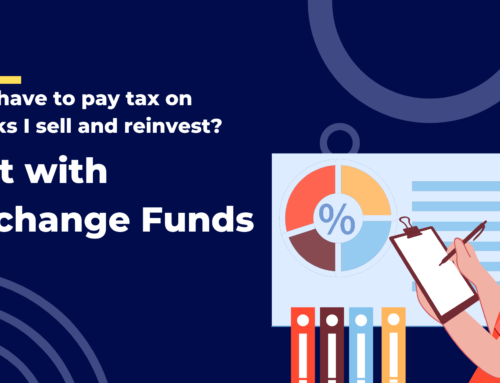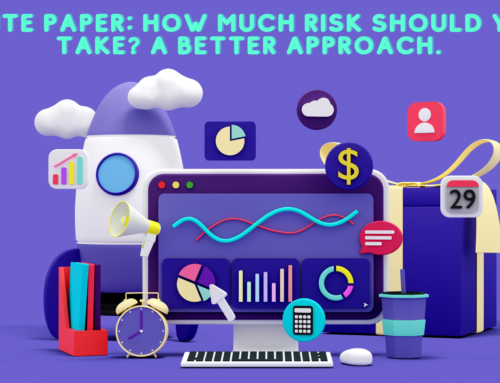This is part three in my series on our current state of knowledge in wealth management, how we got here, and what we can do better. To start at part one click here.
In my last post I explained how Modern Portfolio Theory (MPT) spurred the invention of the index fund, which has come to increasingly dominate the landscape of money management in the 21st century. I ended by pointing out an important disconnect between theory and practice: MPT makes the bold claim that risk is the only thing that determines return, it is impossible to beat the market by picking undervalued assets, and so all investors should own the same portfolio of all the assets in the world weighted by their market value, with more conservative investors putting aside part of their portfolio in cash, and more aggressive investors borrowing cash to leverage their portfolio. The index fund industry goes only part of the way to realizing this vision. Their products offer cheap, market-value weighted exposure to certain asset classes (such as US stocks or US investment grade bonds), but there currently exist no single index fund that invests in the true global market portfolio of all the world’s stocks, bonds, and alternative assets. Instead, bundled solutions like target-retirement funds and the new robo-advisors follow century-old financial planning advice, shifting their investors from stocks to bonds as they get older, more or less sticking to traditional Wall Street ideas of portfolio management from before we had any coherent theory of risk. The use of leverage, a key component of Modern Portfolio Theory, is completely absent from today’s portfolio solutions for the individual investor.
So how did we get here? While the theory always emphasized the global investment marketplace, the early empirical work in finance starting in the 60s focused almost exclusively on the US stock market, probably mostly because that was the easiest to get data on. Comprehensive databases on international stock markets, or even the US bond market, were still virtually nonexistent. Practically speaking, almost no Americans held any international investments, and at the time the US stock market was by far the largest asset class in the world, so most researchers at least tacitly assumed that it was a decent proxy for the global market itself.
One of the earliest empirical studies on investment risk and return looked at the US stock market and found a clear positive relation between the two, shown in the graph that we saw last time.
Though the data was in the right direction, the authors noted that the slope was too flat – theory predicted a 1 for 1 tradeoff between beta (the standard quantitative measure of an asset’s risk) and return, a 45 degree angle coming out of the y-axis. Riskier stocks earned more than less-risky stocks over the long run, but not very much more, at least not as much as they should have. One of the author’s of the paper, Fischer Black, was later recruited by Wells Fargo, along with several other of the early pioneers of Modern Portfolio Theory, to help launch a fund for its institutional investors intended to put some of their ideas into practice. In the development stage, Black pointed to his findings and suggested that they should build a portfolio that was less risky than the market by buying less of the high-beta stocks, and more of the low-beta stocks, then applying leverage (borrowed money) to the portfolio until its risk was the same level as the market again. If the flat-ish relation between risk and return held up, then such a fund would earn greater long-run returns than the overall market, but with roughly the same level of risk.
Wells Fargo rejected the idea, claiming it was too complicated and they couldn’t sell it to their investors. Presumably they wouldn’t have been too fond of throwing in foreign government bonds, convertible securities, gold bullion, and all the countless other assets in the global market portfolio either. In the end, what they launched was the world’s first S&P index fund, opting for something familiar and uncontroversial over what actually made the most sense, in a move that will surprise absolutely nobody who has ever worked in a large organization.
Fischer Black went on to write a paper, probably inspired by his experience, in which he theorized that if there are investors who are unable or unwilling to use leverage, they will tend to favor higher beta assets in order to juice their returns. This will bid up the price of these assets and lower their prospective returns. The tradeoff between risk and return then, is less than the one for one ratio that was originally supposed: lower risk assets should earn higher returns per unit of risk. This was one of the first research papers in the field to treat investors as being and behaving differently, and seemed to go a long way to better describing reality.
Our old friend Dr. Markowitz, in a later paper, went further and explained that if there is limited borrowing, or classes of investors who cannot borrow, then the market portfolio cannot be risk-return efficient. In fact, he writes, “the market portfolio can be about as inefficient as a feasible portfolio can get.” In such a market, aggressive investors who cannot borrow will concentrate in a few, high-beta assets like stocks, conservative investors will own disproportionately safe assets like bonds with some higher-risk fare thrown in for diversification, and aggressive investors who can borrow will concentrate on low-beta assets and lever them up. The market portfolio is just the sum total of all these investors’ interactions, but doesn’t itself represent a portfolio that is desirable to any particular investor.
In this way then, the target-retirement funds and robo-advisors I talked about last time do make more sense in how they move investors progressively from stocks to bonds as they get older, but they do so in a very crude way by using index funds that represent the market portfolio of their underlying asset class. If they are unable to use leverage, they should, for example, load up more on high-beta stocks in the early, aggressive years instead of simply buying an index fund of every stock in the market weighted proportional to its market value.
But then again, that raises the larger question of why don’t they just use leverage?
Lifting the World with Portfolio Leverage
Give me a place to stand, and I shall move the world. – Archimedes, upon demonstrating the principle of the lever.
In 2013 the economists Andrea Frazzini and Lasse Pedersen looked into the empirical significance of Black’s theory in a paper appropriately called Betting Against Beta. Looking across a wide variety of asset classes including US and international stocks, bonds, commodities, and currencies, they find that portfolios that go short high-beta assets and long low-beta ones such that the overall beta is zero earn substantial returns in every asset class studied.
If markets were efficient and index funds were the most efficient portfolios, all of these lines should be flat. You’re not supposed to make money selling risky assets to buy safer ones. Nonetheless, the strategy would have been a highly successful one.
How do investors take advantage of this phenomenon? You don’t need to construct complicated long-short portfolios like an academic financial economist. Simply applying leverage to a portfolio of lower-risk assets has been a strategy that has strongly outperformed over time. In the graph below I take the least volatile quintile of US stocks then apply leverage to them such that the portfolio’s overall volatility is expected to be equivalent to the overall market, which turns out to be about 1.3x leverage (meaning for every dollar in the portfolio I borrow an additional 30 cents to invest).
An aggressive investor could beaten the stock market with the same amount of risk by investing in more conservative stocks with leverage. But that’s still a pretty risky portfolio. What about for a more moderate investor?
For decades the gold standard for the moderate investor has been the “60/40 portfolio” – 60% stocks, 40% bonds. Vanguard founder Jack Bogle himself has recommended this as appropriate for most investors, using plain vanilla index funds of US stocks and bonds. Using the first two funds Vanguard launched – the Vanguard 500 fund and the Vanguard Total Bond Market fund – we can make our own 60/40 portfolio. Such a portfolio, rebalanced monthly, would have earned a 8.4% return since the inception of the Total Bond Market fund in 1987.
Now, what if we use these two funds to take the same leveraged-low-volatility approach? Below, I take a much more conservative portfolio of 25% stocks/75% bonds, which has roughly half the volatility as the 60/40 portfolio, and apply 2x leverage to it (essentially creating a 50/150 portfolio) in order to bring its expected volatility up to match the 60/40 benchmark.
Results are hypothetical and do not include transactions costs. Past Performance is no guarantee of future results. Data available upon request.
The levered portfolio beats the unlevered 60/40 benchmark by over 2% per year, resulting in a near doubling of relative wealth by the end of 2015. Asness, Frazzini, and Pedersen find similar results using US stocks and bonds going back to 1926, as well as for a broader sample of global stocks, bonds, and commodities going back to 1973.
So why hasn’t leverage caught on when both theory and evidence fall so strongly in its favor? Recall from last time that Modern Portfolio Theory is based on several unrealistic assumptions about how investors and markets work. The most egregiously flawed of these, which I have been taking apart in this post, is the assumption that all investors can borrow unlimited amounts for leverage. And not only unlimited amounts – unlimited amounts at the risk-free rate i.e. the rate on short-term Treasury bills. In reality, there’s only one organization in the world that can borrow at the rate of US Treasury bills, and that’s the US Treasury, which is not usually in the business of investment management. Everyone else has to pay at least slightly more, depending on the size of their balance sheet.
In the above graphs I assumed the borrowing rate was the federal funds rate. This is the rate banks charge each other for overnight loans and is effectively the lowest interest rate available to private sector actors at a given time. Most of us are not banks, however, and have to pay more for margin loans necessary for leverage. Interactive Brokers, our preferred broker for margin accounts, as of this writing charges rates starting at federal funds plus 1.5% for amounts under $100,000, with tiers down to +0.25% for multi-million dollar accounts.
So at least under relatively conservative return assumptions, investors with smaller accounts are likely to see most of the benefits of leverage eaten up by the interest payments on their margin loans. This should create a market opportunity for mutual funds and other financial intermediaries to use their economies of scale to provide low-cost access to levered investments for retail investors. Indeed, there is now a large selection of levered ETFs available to investors that have attracted billions of dollars in recent years. Unfortunately, most of them are terrible.
Theory and evidence suggest that levering low-volatility investments is likely to be an effective investing strategy. For purely mathematical reasons, once an asset reaches a sufficiently high level of volatility, applying leverage to it is almost certain to do more harm than good.[1] The providers of and investors in levered ETFs, unfortunately, generally haven’t absorbed this fact, with some of the most popular “solutions” on the market providing levered exposure to such whiplash-inducing assets as gold miners, biotech, and oil futures. In many cases, these levered ETFs have underperformed their unlevered counterparts for years on end despite a positive market. The largest levered ETF on the market, for example – SSO, a 2x levered S&P 500 ETF – has been out for nearly ten years, and far from doubling the 6.8% return of the S&P 500 over that period, has actually underperformed it.
There are a couple low-volatility levered bond ETFs available, but they have attracted less than $100 million in assets between them. There are currently no investment products available to individual investors that systematically seek to apply leverage to a portfolio of low-volatility assets in the manner I have been describing here.[2]
Again, why? I think the reasons relate to something I don’t have nearly as good a theory for: culture. Leverage predates Modern Portfolio Theory and our quantitative understanding of risk. Back when investing was an inherently much more speculative endeavor, those intrepid/foolish enough to buy assets with borrowed money typically were chasing the riskiest fare trying to get rich quick. Not surprisingly, they were usually the first to lose their shirts come a bear market. In the Great Depression, many margin investors lost everything and were widely viewed by the public as destabilizing the system. The SEC was established and various restrictions were placed on investing on margin. To this day, the vast majority of people automatically associate “leverage” and “margin” with “really risky” despite mathematical theorems and empirical research to the contrary. Today’s levered ETFs appeal to the descendants of the margin speculators of yesteryear, trying to turn a quick buck in a strategy that is probably about as rational as investing in lottery tickets. The market for rational, long-term margin investors is, sadly, much smaller.
Which brings me to my next topic: culture does matter; not all (hardly any?) investors are entirely rational; we don’t all know or believe the same things. MPT assumes that all investors are economically rational beings with perfect information. What happens when this isn’t the case? In my next post I’ll look at what happens when we take psychology seriously and consider what a market made of real, imperfect human beings looks like.
[1] This is due to something called variance drain, the fact that for a given arithmetic average return, geometric returns decrease with the square of volatility. For typical values of average return and volatility, the variance drain associated with using 2x or more leverage on broad stock indexes is often greater than the increase in arithmetic return associated with the leverage.
[2] Some would argue that so-called “Risk-Parity” funds fit the bill, and their underlying approach is similar in spirit to the thrust of this post. However, I believe risk-parity as usually practiced is a flawed strategy because of its typically large stakes in commodity futures (as well as some technical issues related to optimization). Commodity futures are arguably not a true capital asset that should earn a risk premium like stocks or bonds, and I believe returns on long-only commodity futures are unlikely to be as high as they were in the past for reasons outlined in this Morningstar article.






